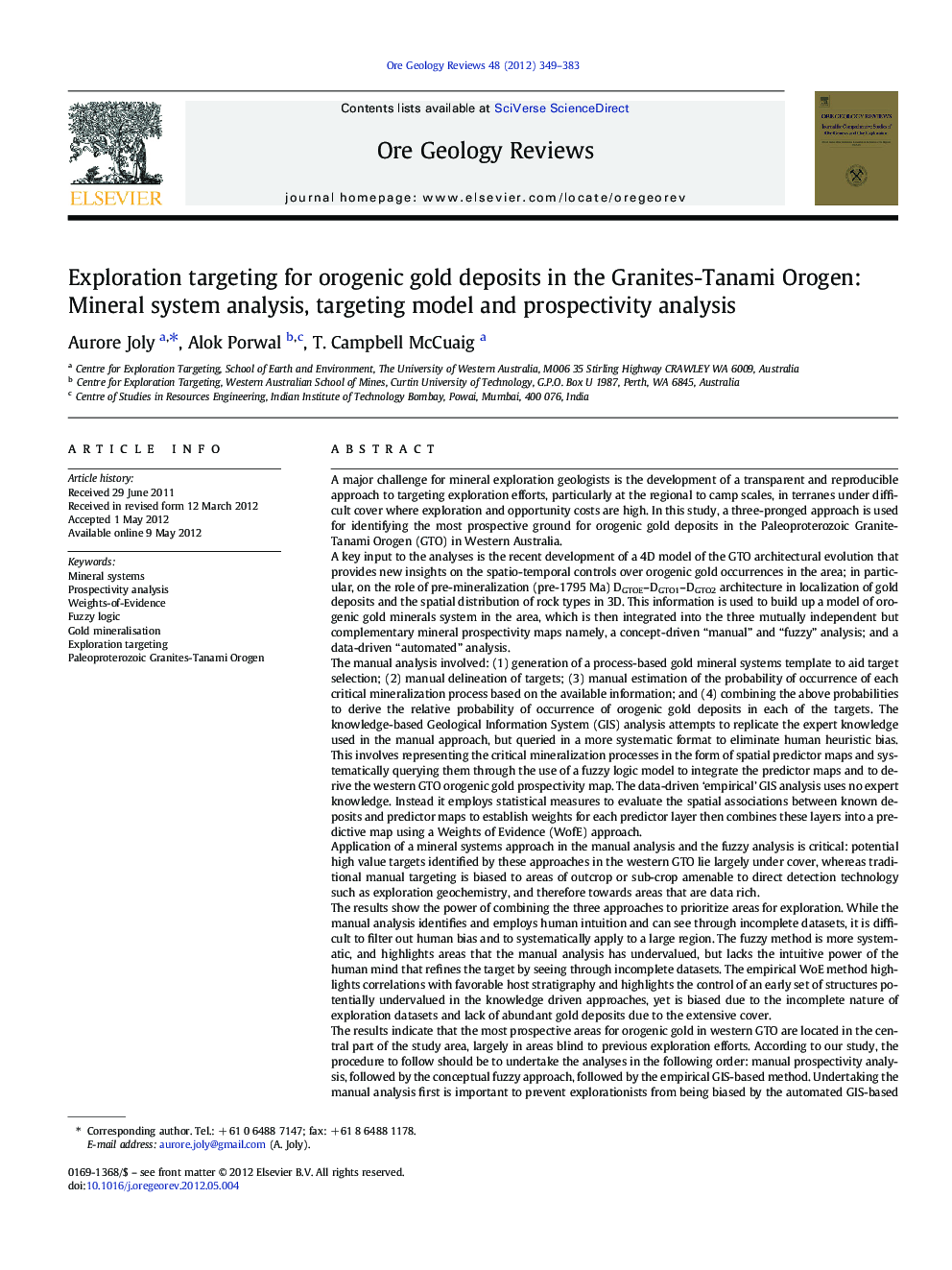| کد مقاله | کد نشریه | سال انتشار | مقاله انگلیسی | نسخه تمام متن |
|---|---|---|---|---|
| 6435955 | 1637255 | 2012 | 35 صفحه PDF | دانلود رایگان |

A major challenge for mineral exploration geologists is the development of a transparent and reproducible approach to targeting exploration efforts, particularly at the regional to camp scales, in terranes under difficult cover where exploration and opportunity costs are high. In this study, a three-pronged approach is used for identifying the most prospective ground for orogenic gold deposits in the Paleoproterozoic Granite-Tanami Orogen (GTO) in Western Australia.A key input to the analyses is the recent development of a 4D model of the GTO architectural evolution that provides new insights on the spatio-temporal controls over orogenic gold occurrences in the area; in particular, on the role of pre-mineralization (pre-1795Â Ma) DGTOE-DGTO1-DGTO2 architecture in localization of gold deposits and the spatial distribution of rock types in 3D. This information is used to build up a model of orogenic gold minerals system in the area, which is then integrated into the three mutually independent but complementary mineral prospectivity maps namely, a concept-driven “manual” and “fuzzy” analysis; and a data-driven “automated” analysis.The manual analysis involved: (1) generation of a process-based gold mineral systems template to aid target selection; (2) manual delineation of targets; (3) manual estimation of the probability of occurrence of each critical mineralization process based on the available information; and (4) combining the above probabilities to derive the relative probability of occurrence of orogenic gold deposits in each of the targets. The knowledge-based Geological Information System (GIS) analysis attempts to replicate the expert knowledge used in the manual approach, but queried in a more systematic format to eliminate human heuristic bias. This involves representing the critical mineralization processes in the form of spatial predictor maps and systematically querying them through the use of a fuzzy logic model to integrate the predictor maps and to derive the western GTO orogenic gold prospectivity map. The data-driven 'empirical' GIS analysis uses no expert knowledge. Instead it employs statistical measures to evaluate the spatial associations between known deposits and predictor maps to establish weights for each predictor layer then combines these layers into a predictive map using a Weights of Evidence (WofE) approach.Application of a mineral systems approach in the manual analysis and the fuzzy analysis is critical: potential high value targets identified by these approaches in the western GTO lie largely under cover, whereas traditional manual targeting is biased to areas of outcrop or sub-crop amenable to direct detection technology such as exploration geochemistry, and therefore towards areas that are data rich.The results show the power of combining the three approaches to prioritize areas for exploration. While the manual analysis identifies and employs human intuition and can see through incomplete datasets, it is difficult to filter out human bias and to systematically apply to a large region. The fuzzy method is more systematic, and highlights areas that the manual analysis has undervalued, but lacks the intuitive power of the human mind that refines the target by seeing through incomplete datasets. The empirical WoE method highlights correlations with favorable host stratigraphy and highlights the control of an early set of structures potentially undervalued in the knowledge driven approaches, yet is biased due to the incomplete nature of exploration datasets and lack of abundant gold deposits due to the extensive cover.The results indicate that the most prospective areas for orogenic gold in western GTO are located in the central part of the study area, largely in areas blind to previous exploration efforts. According to our study, the procedure to follow should be to undertake the analyses in the following order: manual prospectivity analysis, followed by the conceptual fuzzy approach, followed by the empirical GIS-based method. Undertaking the manual analysis first is important to prevent explorationists from being biased by the automated GIS-based outputs. It is however emphasized that all of the prospectivity outputs from these three methods are possible, and they should not be treated as 'treasure maps', but instead, as decision-support aids. Therefore, a final manual prospectivity analysis redefined by the mutual consideration of output from all of the methods is required.The strategy employed in this study constitutes a new template for best-practice in terrane- to camp-scale exploration targeting that can be applied to different terranes and deposit types, particularly in terranes under cover, and provides a step forward in managing uncertainty in the exploration targeting process.
Journal: Ore Geology Reviews - Volume 48, October 2012, Pages 349-383